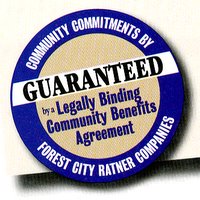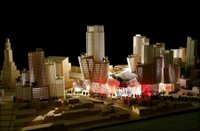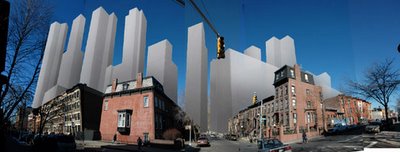I'll provide a summary but not a transcript of my appearance last night on Brian Lehrer Live; however, it will be rebroadcast on Channel 75 on Saturday, 10 a.m. and Sunday, 11 p.m. (time approximate following movie), and an archived videostream is available. Both Forest City Ratner and Borough President Marty Markowitz were invited to send representatives and declined, in part for logistical reasons, said Lehrer.
 The topic was Forest City Ratner's deceptive brochure, and then the subsequent release of Frank Gehry's new renderings of the project. Lehrer introduced me as a "leading opponent" of the plan. I corrected him to say I consider myself a critic and analyst, since "the criticism that I come to is really grounded in facts." I'm not a member of any of the opposition groups, and while my skeptical take is far closer to that of the project opponents than project supporters, they don't speak for me. While my platform makes me a "blogger," I'm a journalist.
The topic was Forest City Ratner's deceptive brochure, and then the subsequent release of Frank Gehry's new renderings of the project. Lehrer introduced me as a "leading opponent" of the plan. I corrected him to say I consider myself a critic and analyst, since "the criticism that I come to is really grounded in facts." I'm not a member of any of the opposition groups, and while my skeptical take is far closer to that of the project opponents than project supporters, they don't speak for me. While my platform makes me a "blogger," I'm a journalist.
"This should really be treated as a campaign commercial," I said. Lehrer agreed that the term "political advertising... seems right to me," given that the company is not directly selling anything. So I, with his help, went through some of the images in the brochure, taking a close look, just as newspapers have begun to analyze and criticize political advertising. After looking at a stock photo of some happy people, I pointed out that, while the brochure does contain some information, it neglects to tell us, for example, about Forest City Ratner's plan for interim surface parking on two large blocks in the eastern portion of the site.
 Lehrer pointed to a fisheye photo of the railyards, over a vertical view of the site plan, in which the 16 towers are outlined in red. I noted that a green fuzzy section is the projected arena location. Lehrer, channeling the average recipient of the brochure, declared, "That's a basketball arena, it looks more like a forest."
Lehrer pointed to a fisheye photo of the railyards, over a vertical view of the site plan, in which the 16 towers are outlined in red. I noted that a green fuzzy section is the projected arena location. Lehrer, channeling the average recipient of the brochure, declared, "That's a basketball arena, it looks more like a forest."
Community Benefits
 We looked at the "guaranteed" seal promising community benefits. I pointed out that Forest City Ratner seems to have put aside its old slogan "Jobs, Housing, and Hoops," likely because the estimate of permanent office jobs has been cut from 10,000 to 2500. I noted that the concept of a Community Benefits Agreement (CBA) is legitimate, and becoming more common, but that the Brooklyn CBA has some distinct differences with the ones signed in Los Angeles. The latter involve coalitions of 20 to 30 groups; in Brooklyn, it's eight groups. (I didn't have time to add that several have no track record in the issues they're supposed to monitor.)
We looked at the "guaranteed" seal promising community benefits. I pointed out that Forest City Ratner seems to have put aside its old slogan "Jobs, Housing, and Hoops," likely because the estimate of permanent office jobs has been cut from 10,000 to 2500. I noted that the concept of a Community Benefits Agreement (CBA) is legitimate, and becoming more common, but that the Brooklyn CBA has some distinct differences with the ones signed in Los Angeles. The latter involve coalitions of 20 to 30 groups; in Brooklyn, it's eight groups. (I didn't have time to add that several have no track record in the issues they're supposed to monitor.)
And I pointed out that the strongest criticism didn't come from me, but from the head of the Community Board in West Harlem, which is negotiating a CBA with Columbia University; he said that they don't want to copy the Brooklyn model. (I didn't cite the source, which was the New York Observer's blog The Real Estate.)
What's missing

 Lehrer pointed to images not in the brochure: the renderings of the 16-tower project from July 2005 (left) and May 2006. "It's really dense," he said. I pointed out that I'm working on a rough comparison: the Atlantic Yards project would be almost 7000 apartments over 22 acres; doubled, that would be 14,000 units over 44 acres. Battery Park City, at full buildout, will be 14,000 apartments over 92 acres. That makes Atlantic Yards twice as dense. It's more complicated than that, since each project has other buildings, but it's a striking contrast.
Lehrer pointed to images not in the brochure: the renderings of the 16-tower project from July 2005 (left) and May 2006. "It's really dense," he said. I pointed out that I'm working on a rough comparison: the Atlantic Yards project would be almost 7000 apartments over 22 acres; doubled, that would be 14,000 units over 44 acres. Battery Park City, at full buildout, will be 14,000 apartments over 92 acres. That makes Atlantic Yards twice as dense. It's more complicated than that, since each project has other buildings, but it's a striking contrast.
Commenting on Frank Gehry's 2005 design, Lehrer pointed to the tilted buildings, and called one "The leaning tower of Prospect Heights." I noted that the project had gone down five percent from the previous iteration, but was still bigger than the announced plan in December 2003, and that the New York Observer had called the recent scaleback "token" changes.
Miss Brooklyn
We took a look at the central tower, which Gehry has dubbed "Miss Brooklyn." I noted that Gehry has said he was inspired both by a Brooklyn wedding and also by the Brooklyn Bridge. "I'd like to hear him explain it a bit more," I said. "Do you see Brooklyn Bridge?" This is where a representative of the architect or the developer would have been helpful.
Lehrer read a quote from Gehry, who said of project opponents: "They should've been picketing Henry Ford." I said that it's distressing that Gehry's polarizing things, since he himself has said the project is "out of scale" and that it's "coming way back." Obviously, I said, he recognizes that the scale is an issue, but he has constraints and must work for a client.
 Lehrer showed an image from OnNYTurf, in which Will James has tried to show--using a previous iteration of the plan--what the towers would look like from the neighborhood. I pointed out that Forest City Ratner has in fact released renderings with neighborhood views, but they downplay the towers.
Lehrer showed an image from OnNYTurf, in which Will James has tried to show--using a previous iteration of the plan--what the towers would look like from the neighborhood. I pointed out that Forest City Ratner has in fact released renderings with neighborhood views, but they downplay the towers.
What say to supporters
In a final question, Lehrer said that people support the project because of jobs and affordable housing, and asked how I'd respond to people who say those in Brownstone Brooklyn critical of the plan are privileged and elite. I pointed out that, essentially this is a luxury housing project, with nearly 2400 market-rate condos, probably at $1 million each, and 2250 market-rate rentals, along with 2250 affordable rentals.
I said it's not my role to debate supporters so much as to discuss how we frame the issues. At a cost of $3.5 billion, with over $1 billion in public investment (including subsidies and public costs), it's kind of a backward way to create jobs. (I inaccurately mentioned "3900 new jobs." Actually, Forest City Ratner cites 3740 new permanent jobs; by my calculation, including the temporary construction jobs, only 3090 jobs would be new.)
As for affordable housing, there's certainly a case for both density and affordable housing at the railyard site, I said, but we could build a lot more affordable housing if we reformed the city's 421-a subsidy program, which last year cost the city $320 million.
I didn't have time to connect the dots: affordable housing seems to be used as the justification for building something out of scale with zoning and the surrounding neighborhood. In other areas of the city, the inclusion of affordable housing allows developers to build bigger, but that's part of a publicly-negotiated zoning bonus. But there's been no rezoning for the Atlantic Yards project, so the deal between Forest City Ratner and ACORN is essentially a privately-negotiated zoning bonus, with no oversight.
 The topic was Forest City Ratner's deceptive brochure, and then the subsequent release of Frank Gehry's new renderings of the project. Lehrer introduced me as a "leading opponent" of the plan. I corrected him to say I consider myself a critic and analyst, since "the criticism that I come to is really grounded in facts." I'm not a member of any of the opposition groups, and while my skeptical take is far closer to that of the project opponents than project supporters, they don't speak for me. While my platform makes me a "blogger," I'm a journalist.
The topic was Forest City Ratner's deceptive brochure, and then the subsequent release of Frank Gehry's new renderings of the project. Lehrer introduced me as a "leading opponent" of the plan. I corrected him to say I consider myself a critic and analyst, since "the criticism that I come to is really grounded in facts." I'm not a member of any of the opposition groups, and while my skeptical take is far closer to that of the project opponents than project supporters, they don't speak for me. While my platform makes me a "blogger," I'm a journalist."This should really be treated as a campaign commercial," I said. Lehrer agreed that the term "political advertising... seems right to me," given that the company is not directly selling anything. So I, with his help, went through some of the images in the brochure, taking a close look, just as newspapers have begun to analyze and criticize political advertising. After looking at a stock photo of some happy people, I pointed out that, while the brochure does contain some information, it neglects to tell us, for example, about Forest City Ratner's plan for interim surface parking on two large blocks in the eastern portion of the site.
 Lehrer pointed to a fisheye photo of the railyards, over a vertical view of the site plan, in which the 16 towers are outlined in red. I noted that a green fuzzy section is the projected arena location. Lehrer, channeling the average recipient of the brochure, declared, "That's a basketball arena, it looks more like a forest."
Lehrer pointed to a fisheye photo of the railyards, over a vertical view of the site plan, in which the 16 towers are outlined in red. I noted that a green fuzzy section is the projected arena location. Lehrer, channeling the average recipient of the brochure, declared, "That's a basketball arena, it looks more like a forest."Community Benefits
 We looked at the "guaranteed" seal promising community benefits. I pointed out that Forest City Ratner seems to have put aside its old slogan "Jobs, Housing, and Hoops," likely because the estimate of permanent office jobs has been cut from 10,000 to 2500. I noted that the concept of a Community Benefits Agreement (CBA) is legitimate, and becoming more common, but that the Brooklyn CBA has some distinct differences with the ones signed in Los Angeles. The latter involve coalitions of 20 to 30 groups; in Brooklyn, it's eight groups. (I didn't have time to add that several have no track record in the issues they're supposed to monitor.)
We looked at the "guaranteed" seal promising community benefits. I pointed out that Forest City Ratner seems to have put aside its old slogan "Jobs, Housing, and Hoops," likely because the estimate of permanent office jobs has been cut from 10,000 to 2500. I noted that the concept of a Community Benefits Agreement (CBA) is legitimate, and becoming more common, but that the Brooklyn CBA has some distinct differences with the ones signed in Los Angeles. The latter involve coalitions of 20 to 30 groups; in Brooklyn, it's eight groups. (I didn't have time to add that several have no track record in the issues they're supposed to monitor.) And I pointed out that the strongest criticism didn't come from me, but from the head of the Community Board in West Harlem, which is negotiating a CBA with Columbia University; he said that they don't want to copy the Brooklyn model. (I didn't cite the source, which was the New York Observer's blog The Real Estate.)
What's missing

 Lehrer pointed to images not in the brochure: the renderings of the 16-tower project from July 2005 (left) and May 2006. "It's really dense," he said. I pointed out that I'm working on a rough comparison: the Atlantic Yards project would be almost 7000 apartments over 22 acres; doubled, that would be 14,000 units over 44 acres. Battery Park City, at full buildout, will be 14,000 apartments over 92 acres. That makes Atlantic Yards twice as dense. It's more complicated than that, since each project has other buildings, but it's a striking contrast.
Lehrer pointed to images not in the brochure: the renderings of the 16-tower project from July 2005 (left) and May 2006. "It's really dense," he said. I pointed out that I'm working on a rough comparison: the Atlantic Yards project would be almost 7000 apartments over 22 acres; doubled, that would be 14,000 units over 44 acres. Battery Park City, at full buildout, will be 14,000 apartments over 92 acres. That makes Atlantic Yards twice as dense. It's more complicated than that, since each project has other buildings, but it's a striking contrast.Commenting on Frank Gehry's 2005 design, Lehrer pointed to the tilted buildings, and called one "The leaning tower of Prospect Heights." I noted that the project had gone down five percent from the previous iteration, but was still bigger than the announced plan in December 2003, and that the New York Observer had called the recent scaleback "token" changes.
Miss Brooklyn
We took a look at the central tower, which Gehry has dubbed "Miss Brooklyn." I noted that Gehry has said he was inspired both by a Brooklyn wedding and also by the Brooklyn Bridge. "I'd like to hear him explain it a bit more," I said. "Do you see Brooklyn Bridge?" This is where a representative of the architect or the developer would have been helpful.
Lehrer read a quote from Gehry, who said of project opponents: "They should've been picketing Henry Ford." I said that it's distressing that Gehry's polarizing things, since he himself has said the project is "out of scale" and that it's "coming way back." Obviously, I said, he recognizes that the scale is an issue, but he has constraints and must work for a client.
 Lehrer showed an image from OnNYTurf, in which Will James has tried to show--using a previous iteration of the plan--what the towers would look like from the neighborhood. I pointed out that Forest City Ratner has in fact released renderings with neighborhood views, but they downplay the towers.
Lehrer showed an image from OnNYTurf, in which Will James has tried to show--using a previous iteration of the plan--what the towers would look like from the neighborhood. I pointed out that Forest City Ratner has in fact released renderings with neighborhood views, but they downplay the towers.What say to supporters
In a final question, Lehrer said that people support the project because of jobs and affordable housing, and asked how I'd respond to people who say those in Brownstone Brooklyn critical of the plan are privileged and elite. I pointed out that, essentially this is a luxury housing project, with nearly 2400 market-rate condos, probably at $1 million each, and 2250 market-rate rentals, along with 2250 affordable rentals.
I said it's not my role to debate supporters so much as to discuss how we frame the issues. At a cost of $3.5 billion, with over $1 billion in public investment (including subsidies and public costs), it's kind of a backward way to create jobs. (I inaccurately mentioned "3900 new jobs." Actually, Forest City Ratner cites 3740 new permanent jobs; by my calculation, including the temporary construction jobs, only 3090 jobs would be new.)
As for affordable housing, there's certainly a case for both density and affordable housing at the railyard site, I said, but we could build a lot more affordable housing if we reformed the city's 421-a subsidy program, which last year cost the city $320 million.
I didn't have time to connect the dots: affordable housing seems to be used as the justification for building something out of scale with zoning and the surrounding neighborhood. In other areas of the city, the inclusion of affordable housing allows developers to build bigger, but that's part of a publicly-negotiated zoning bonus. But there's been no rezoning for the Atlantic Yards project, so the deal between Forest City Ratner and ACORN is essentially a privately-negotiated zoning bonus, with no oversight.
Comments
Post a Comment